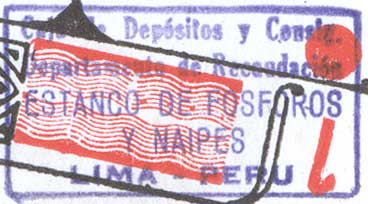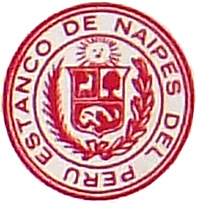Estanco de Naipes del Perú
In October 1888 the Republic of Peru Congress passed Law no.26 establishing taxes on playing cards, whether imported or locally produced, according to the quality of the cards.
Established in 1781 by the Spanish government to control the sale of playing cards in the American colonies, the purpose was to administer the importation of playing cards from Spain. Packs had secret markings to facilitate the detection of fraud, and a hierarchy of uniformed officials controlled operations. At some point this was superseded by Peruvian laws when it became a state monopoly garnering revenues for the national treasury.
In October 1888 the Republic of Peru Congress passed Law no.26 establishing taxes on playing cards, whether imported or locally produced, according to the quality of the cards:
-
imported 'ordinary' cards, 2 centavos per pack;
-
imported semi-fine and children's packs, 4 centavos per pack;
-
imported high quality packs (including English & French packs), 8 centavos per pack.
-
Packs manufactured in Peru, 2 centavos per pack. The law does not state how the payment of the taxes was controlled.
 The Estanco de Naipes appears to have been
preceded by the Government's Caja de Depósitos y Consignas, Departamento
de Recaudación, Estanco de Fósforos y Naipes
- but further details are not currently available.
The Estanco de Naipes appears to have been
preceded by the Government's Caja de Depósitos y Consignas, Departamento
de Recaudación, Estanco de Fósforos y Naipes
- but further details are not currently available.
In Law no.4936 (Item 'G', Jan. 1924) The Estanco de los Naipes was created.

Above: Peruvian "Estanco de Naipes" tax band which was presumably wrapped around the outside of each pack (1924-67). The printer's name, which can be read at the lower right-hand end of the tax band, is: Lit. T. Scheunch, Lima.
Whilst local playing card production in Perú was sparse, foreign manufacturers supplied playing cards specially for the Estanco de Naipes del Perú. The logo of the Estanco de Naipes usually appears on the reverse of the cards, whilst special text appears overprinted on the box, ace of spades or joker:
'Aladdin 1001' and Caravan playing cards were manufactured by U.S.P.C.C.►
'Bosco' playing cards were manufactured by ASS (Germany)►
De Luxe Bridge playing cards manufactured by Ferd. Piatnik & Sons (Vienna)►
'El Caballo' Spanish playing cards manufactured by Fournier (Spain)►
'TOYO Playing Card' manufactured in China.
Anonymous 'M' Spanish-suited playing cards►
Playing card brands manufactured in Japan►
Tobacco advertising playing cards by Van Genechten (Belgium)►

In Law no.16754 (Nov. 1967) the Estanco de los Naipes was abolished and a duty on imported playing cards imposed according to their quality:
Playing cards made from cardboard, 5.00 soles per pack;
Plastic playing cards, 50.00 soles per pack.
Home produced playing cards continued to be taxed according to established national laws.

By Simon Wintle
Member since February 01, 1996
I am the founder of The World of Playing Cards (est. 1996), a website dedicated to the history, artistry and cultural significance of playing cards and tarot. Over the years I have researched various areas of the subject, acquired and traded collections and contributed as a committee member of the IPCS and graphics editor of The Playing-Card journal. Having lived in Chile, England, Wales, and now Spain, these experiences have shaped my work and passion for playing cards. Amongst my achievements is producing a limited-edition replica of a 17th-century English pack using woodblocks and stencils—a labour of love. Today, the World of Playing Cards is a global collaborative project, with my son Adam serving as the technical driving force behind its development. His innovative efforts have helped shape the site into the thriving hub it is today. You are warmly invited to become a contributor and share your enthusiasm.
Related Articles

French Revolutionary cards by Pinaut
Seven cards from a French Revolutionary pack by Pinaut featuring characters from classical antiquity...

Rouen Pattern - Portrait Rouennais
An attractive XV century French-suited design from Rouen became the standard English & Anglo-America...

Archaic Spanish proof sheets
2 x uncoloured proof sheets of archaic Spanish-suited playing cards produced for “New Spain”, possib...

Ganjifa - Playing Cards from India
Indian playing cards, known as Ganjifa, feature intricate designs with twelve suits and are traditio...

Moguls, Highlanders and Merry Andrews
Discover the historic origins and evolution of card naming and quality designations like ‘Moguls’ an...

The Henry Hart Puzzle
Explore the intricate history and unique design variations of Henry Hart's playing cards, tracing th...

Sevilla 1647 reproduction
Facsimile of Spanish-suited pack produced in Sevilla, Spain, 1647.

Why our playing-cards look the way they do
Analysis of early playing card designs: origins, suit differences, standardization, technological ad...

Introduction to Collecting Themes
Playing cards can be broadly categorised into standard and non-standard designs, with collectors app...

Le Monde Primitif Tarot
Facsimile edition produced by Morena Poltronieri & Ernesto Fazioli of Museo Internazionale dei Taroc...

75: Early American cards
An overview of some of the early cards made in the United States.

Mario Testino playing cards
A selection of Mario Testino’s photographic work in various fields, notably fashion.

Early German playing cards
Some early examples of popular German playing cards from the XV and XVI centuries.

The Parisian Tarot
The “Parisian Tarot”, early 1600s, with imagery and design synthesizing several influences.

73: Fakes, Forgeries and Tax Evasion
When there are official taxes to pay, people will find a way to avoid paying them - often illegally....

Russian Playing Card History - From the Beginnings to 1917
An in-depth review of the history of card-playing, gambling, legislation, manufacture and taxation o...
Most Popular
Our top articles from the past 28 days

